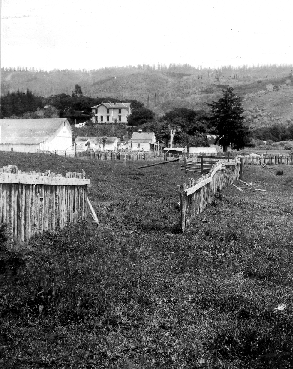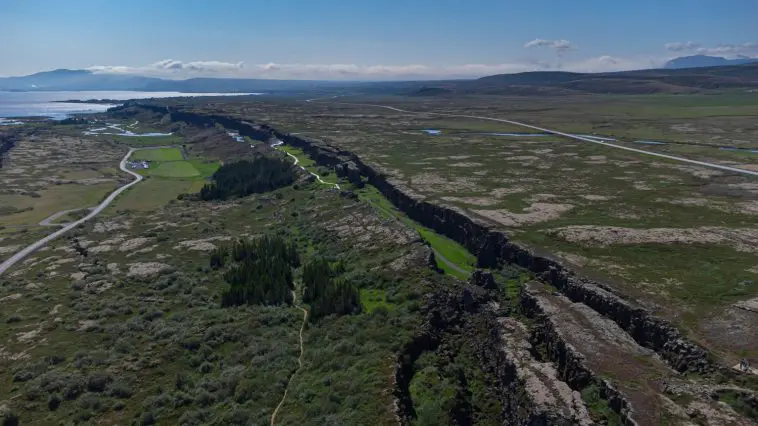[Originally published as the first part of A Biblical Perspective on Plate Tectonics]
By Christian Ryan
We do not often think of planet Earth as a living thing. But in a way, it kind of is. The Earth is an active system with volcanoes on land and at the bottom of the sea, fluctuations in sea level, earthquakes, marching and melting of glaciers, and climate changes. Not to mention all of the biological processes. Yes, all of these processes are governed by a phenomenon that lies beneath our feet: plate tectonics.
The views expressed in this article reflect those of the author mentioned, and not necessarily those of New Creation.
What is Plate Tectonics?
Looking at planet Earth from outer space, you might think you are looking at a uniform ball of rock covered in a mosaic of plant life and water. However, let’s remove the flora and water from Earth’s surface. This reveals that the outer surface of the Earth, called the crust, consists of very large broken pieces or fragments called “tectonic plates.” These tectonic plates fit together like pieces of the world’s largest jigsaw puzzle. While you probably don’t feel it right now, these plates are never stationary.
Plate tectonics is a scientific theory that explains the movements and interactions of these tectonic plates. As tectonic plates move in relation to each other across the planet’s surface, they interact in a number of ways. They can spread apart at divergent boundaries. They can also crash into or slide over each other, creating convergent boundaries. Further, they can simply slide past one another at transform boundaries.
There are two main types of tectonic plates: continental plates and oceanic plates. These plates float on the Earth’s mantle, a thick layer of hot, solid rock between the crust. The mantle flows very slowly over very long periods of time, almost like melted plastic. Continental plates are thicker and made of less dense rocks, mostly granite. Meanwhile, oceanic plates are thinner and composed primarily of denser basalt. Because of this, continental plates sit higher on the mantle than oceanic plates. This is why continental plates usually rise above sea level as dry land, while oceanic plates typically form the deeper ocean basins.
How Do Tectonic Plates Move?
The reason tectonic plates move in the first place has to do with what lies underneath the Earth’s surface. If you cut the planet in half, you would see that it consists of layers. Each layer has a different composition and physical behavior. The lithosphere is a rigid, outer layer that includes both the crust and the uppermost part of the mantle. Beneath it is the asthenosphere, a hotter, softer part of the upper mantle. It is so hot it behaves like slow-flowing, putty over long periods of time.
The tectonic plates that make up the lithosphere “float” on the slow-moving asthenosphere below. Driving this motion is a combination of forces, including gravity pulling down oceanic plates into the asthenosphere when they collide with continental plates. We call this process subduction. Another force is the slow circulation of material within the mantle. Scientists are still working to understand how these and other forces interact. Nevertheless, together these forces send plates aloft like ships on a molten sea, though at a pace of just a few centimeters per year. That’s about as fast as your fingernails grow.
How Did We Discover Plate Tectonics?
Plate tectonics itself is a relatively recent geologic discovery. However, the earliest speculations about continental movements go back hundreds of years. Many early advocates of this idea were geographers. They recognized the jigsaw puzzle-like shape of the continents on either side of the Atlantic Ocean.
In 1596, Catholic geographer Abraham Ortelius suggested that the Americas used to be joined up with the other continents until they “[tore] away from Europe and Africa…by earthquakes and floods.”1 Some, such as German professor of Theology Theodor Christoph Lilienthal in 1756, tied this idea to when the earth “divided in the days of Peleg.”2 Others, like French geographer Antonio Snider Pellegrini in 1858, thought this break-up happened during the Noahic Flood.
Such ideas did not move beyond preliminary speculations for centuries. Finally, in 1912, German meteorologist Alfred Wegener put forward his theory of continental drift. He argued that all of the continents were originally joined together into a single continent called Pangaea. This landmass slowly drifted apart over time. He thought it moved independently through the oceanic crust, rather than as part of larger tectonic plates as we do today.
Alfred Wegener was the first to popularize the idea of continental movements over time.
The scientific community rejected his theory for several reasons. For example, Wegener’s model required continents to fracture the seafloor as they moved, like a ship breaking its way through icebergs.
It was not until the 1960s that mapping of the deep seafloor revealed that the oceanic crust, like the continental crust, had divided into fragments (now called tectonic plates). The movements of these oceanic plates provided the missing mechanism necessary for Wegener’s continental drift idea to work. This led to the fully fleshed-out model known today at plate tectonics.
Plate Tectonics is a Useful Scientific Theory

Though initially the subject of much skepticism, the theory of plate tectonics has become a useful scientific theory. It manages to explain a wide range of natural phenomena. The overall shape of the continents along either side of the Atlantic fit very nicely together, like giant puzzle pieces. The distribution of volcanoes, mountain ranges, and earthquake hotspots closely mirror the edges of tectonic plates. Because seafloors constantly form and recycle, the theory of plate tectonics also explains why oceanic crust is significantly younger than continental crust. And thanks to satellites and GPS stations, we know that plate tectonics is not just a thing of the past. We can directly observe and document the slow and steady movement of continents today.
Although an exceedingly useful scientific model, plate tectonics does pose some questions for those trying to understand the world from a young-earth perspective.
Today, tectonic plates move at roughly 1.5 cm/yr. At this rate, it would take hundreds of millions of years for the continents to split and assume their modern configuration. This far exceeds the young-age timeline from Scripture.
Is it possible that plate tectonics operated at a much, much faster rate in the past?
Catastrophic Plate Tectonics
In the 1980s, geophysicist Dr. John Baumgardner began developing the foundation of a plate tectonics model to explain tectonic plate activity on a much shorter timescale.3 A group of geoscientists joined Baumgardner, and the model became known as catastrophic plate tectonics (CPT).4
Given the devastating consequences tectonic activity can have on lifeforms, Baumgardner and his team suggested that most of this occurred during the biblical Flood, rather than after the Flood when life was supposed to be recovering and recolonizing the Earth.
According to the CPT model, Earth’s continents originally belonged to a single supercontinent surrounded by denser, cooler oceanic crust. When the Flood began, the oceanic crust suddenly fractured. Large portions sank into the mantle beneath the supercontinent. As these slabs of oceanic crust sank, they pulled more of the ocean floor with them. This triggered a process called runaway subduction.
What is Runaway Subduction?
What differentiates regular subduction from CPT is that the former is relatively stable and occurs at by-in-large the same rate. Runaway subduction, however, results in a feedback loop. Essentially, the faster an oceanic crustal slab sinks, the weaker it makes the surrounding mantle rock. This decreases the resistance, allowing the slabs to sink even faster, which in turn makes the surrounding mantle rock weaker, which decreases the resistance and allows slabs to sink even faster…and so on. We can liken it to how struggling in quicksand makes you sink faster.
According to Baumgardner, the subducting oceanic plates sank faster and faster. Eventually their speed reached a human walking pace of several feet per second. This displaced mantle material and forced hot, buoyant rock to rise at divergent plate boundaries and form new ocean floors. The introduction of a new seafloor made the bottom of the pre-Flood oceans sit at a more even level with the continents. Thus, the holding volume of the ocean basins was reduced and sea levels rose. What was once dry land became flooded by a depth of up to a mile (~1.6 km) of seawater.
Once all the pre-Flood oceanic crust had been replaced, the runaway subduction ceased. The seafloor began to cool and sink, increasing the holding capacity of the oceans. This allowed the floodwaters to recede, drawing water back into the ocean basins, where they remain to this day.
Evidence for Catastrophic Plate Tectonics
Plate tectonics accounts for more geologic phenomena than any previously proposed model of the Earth’s structure. Yet, catastrophic plate tectonics can account for all of that, and much more.
Here Comes the Sea
Fossils of fish, ammonites, sea turtles, mosasaurs and many other sea creatures are regularly found thousands of feet above current sea level. There is not nearly enough water on Earth for the global sea level to rise this high. Even if all of the glaciers and ice caps melted, the ocean would only rise about 295 feet (90 meters). Additionally, many of these marine fossils are found in undeformed layers of sedimentary rock. This means their presence above sea level cannot simply be explained by mountain uplift.
Where did all of this water come from?
The only way to accomplish this is by decreasing the ocean’s holding volume by producing lots of young, hot and buoyant oceanic crust. Even old-earth geologists have come to acknowledge that seafloor tectonics must have been operating much faster than they are today in order to explain this phenomenon. Granted, on its own, this is not an argument for catastrophic plate tectonics. But neither does it accord with the fingernail-growth speeds of tectonics we observe in the present. Clearly, seafloor spreading rates have not been uniform across all of Earth’s history.
Mega-Earthquakes

The geologic record is full of evidence for large-scale earthquakes far larger than any observed in recent, historic times. For example, the Hanson Ranch Bonebed in Wyoming’s Lance Formation has thick layers of warped, swirly sandstone, called seismite [similar to what is shown above, but thicker]. These occur when an earthquake causes water-laden sediment to disturb the layers.
Many of the deformed layers in the Lance Formation are quite thick, some measuring over 15 feet in thickness!5 To put this into perspective, a 5.5 magnitude earthquake might leave behind a seismite about one-inch in thickness.6 So clearly, the earthquakes that formed the seismites in the Lance Formation were hundreds or thousands of times more powerful than any known from recent history.
Given that earthquakes are caused by adjustments along Earth’s tectonic plate margins, this is indirect evidence that they were much more active in the past.7
Footnotes
- Kious, W.J.; Tilling, R.I. (2001) [1996]. “‘Historical perspective’. This Dynamic Earth: the Story of Plate Tectonics” (Online ed.). U.S. Geological Survey. ISBN 0-16-048220-8. Retrieved 29 January 2008.; Ortelius, Thesaurus Geographicus (Antwerp, (Belgium): Officina Plantiniana [Plantin Press] 1596), entry: “Gadiricus.”
- Meinhold, G., & Celâl Şengör, A. M. (2019). “A historical account of how continental drift and plate tectonics provided the framework for our current understanding of palaeogeography.” Geological Magazine, 156(2), 182-207.
- Baumgardner, John R. (1986). “Numerical Simulation of the Large-Scale Tectonic Changes Accompanying the Flood.” Proceedings of the International Conference on Creationism: Vol. 1, Article 56.
- Austin, Steven A.; Baumgardner, John R.; Humphreys, D. Russell; Snelling, Andrew A.; Vardiman, Larry; and Wise, Kurt P. (1994). “Catastrophic Plate Tectonics: A Global Flood Model of Earth History.” Proceedings of the International Conference on Creationism: Vol. 3, Article 56.
- Snyder, K., McLain, M., Wood, J., & Chadwick, A. (2020). “Over 13,000 elements from a single bonebed help elucidate disarticulation and transport of an Edmontosaurus thanatocoenosis.” PLoS One, 15(5), e0233182.
- Austin, S.A., 2012, November. Jerusalem earthquake of 33 AD: evidence within laminated mud of the Dead Sea, Israel. In 2012 GSA Annual Meeting in Charlotte. GSA.
- Garner, P. [Biblical Creation Trust]. (2021, October 5). Earthquakes in a scientific and biblical context, YouTube.







